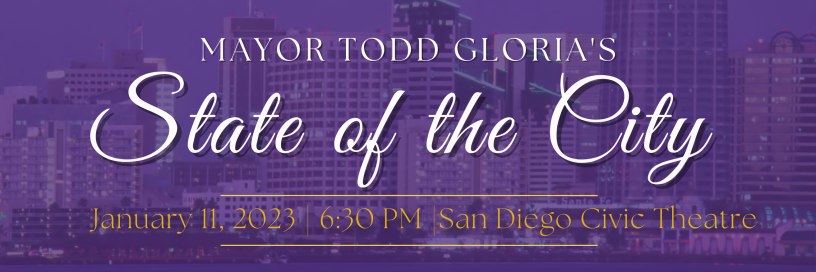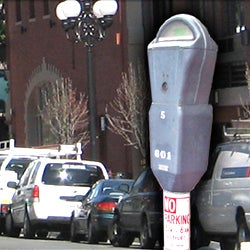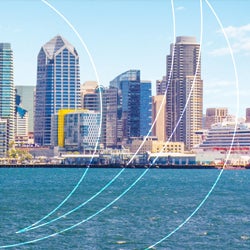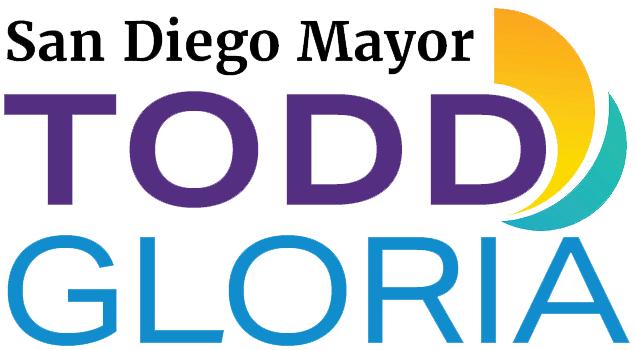Mayor Todd Gloria's 2023 State of the City Address


SAN DIEGO MAYOR TODD GLORIA

Mayor Todd Gloria's 2023 State of the City Address
Translation
Good evening.
City Council President Elo-Rivera.
Members of the City Council.
City Attorney Elliott.
Chief Operating Officer Dargan.
Distinguished guests from throughout California and the region; local tribal leaders; military leaders; and officials from Baja California and around the world.
And, our dedicated City of San Diego employees.
Thank you all so much for being here.
***
My fellow San Diegans,
When I took the reins of our city in 2020, I declared that the state of our city was fragile.
Fragile – as we navigated the continued uncertainty of COVID-19;
Fragile – in the face of a looming budget shortfall caused by the pandemic; and,
Fragile – as a result of a host of civic issues left unaddressed.
Last year, after successful efforts to get San Diegans vaccinated; after securing federal aid from the Biden-Harris Administration and Congress through the American Rescue Plan; and after finally checking off items that sat for years atop a long civic to-do list – issues like short-term vacation rentals, the Barrio Logan Community Plan, sidewalk vending and more -- I declared that the State of our City was ready.
Ready to recover. Ready to rebuild. And ready to continue solving the tough problems we face together.
Tonight, I am honored to be with you to deliver my third State of the City address as San Diego’s 37th Mayor – and my first in-person with a live audience.
That we are here together again is a testament to our progress – our triumph over the COVID-19 pandemic driven by our determination to be together – to work together – to rebuild our city and embark on a new era of prosperity.
When I became your Mayor, I pledged that I was coming to City Hall to get things done.
I promised to tackle our challenges head-on with the sustained effort it takes to make real change.
I pledged to listen to communities that have been neglected by City Hall and to act on their behalf.
That neglect has long been evident in the City’s lack of investment in infrastructure and the impacts that has on our daily lives: a bent car axle caused by a pothole; a boil-water order because of a ruptured water main; concern about walking in neighborhoods because of broken streetlights or buckled sidewalks.
Or... a complete lack of sidewalks, as was the case for Daneyel and Tommy Walker of Paradise Hills.
Daneyel and Tommy are the proud owners of several small businesses, including The Mental Bar, a coffee house in the Black Arts and Culture District.
For years, the Walkers – like so many residents of our Southeastern San Diego neighborhoods – wanted their community to be beautiful, free of weeds and graffiti and revitalized with street repairs and new streetlights and sidewalks – not only in Paradise Hills where they live, but also Encanto, where they work.
They watched with dismay as the neighborhood’s full potential went unrealized.
So, the Walkers joined the Project Reo Collective, an informal neighborhood group, and Tommy began serving on the Paradise Hills Planning Committee and the Paradise Hills Park and Recreation Board – all to help improve their community.
It’s been a long time coming, but with the commitment and partnership of Council President Pro tem Monica Montgomery Steppe, I’m pleased to report we are getting it done.
More than 1,200 feet of new sidewalks. New and fixed streetlights. Freshly paved streets. All underway.
The Walkers are here with us this evening – and I want to take this opportunity to thank them and their neighbors for their persistent advocacy.
Now, let’s be clear: years-long advocacy for basic city infrastructure shouldn’t be necessary.
That’s why from day one of my administration, I have focused on bringing infrastructure upgrades, maintenance, and repairs equitably to every community.
It’s why my “Ready to Rebuild” budget last year was the largest investment in infrastructure in our city’s history, to help fix more streets and bring more sidewalks to neighborhoods like the Walkers’.
It’s true that the City has struggled for years to keep up with necessary sidewalk repairs.
Some of you may know that, under state law, many sidewalk repairs are the responsibility of the adjacent property owner.
The red tape and expense of the current process means few residents actually make those repairs.
It’s high time we take a different approach.
This year, my administration will bring forward reforms to accelerate sidewalk improvements.
Our new effort will streamline permitting and reduce fees to make it less daunting and costly for residents and businesses to fix broken sidewalks in front of their property.
We’re also going a step further by establishing a City-managed contract to efficiently program repairs and allow property owners to access this repair work at an even lower cost.
With all this talk about sidewalks, I hope you don’t think I’ve lost that loving feeling for road repair.
I’m still with my fellow San Diegans in our continued quest to fix the damn roads! And we are getting it done.
By the end of this fiscal year, we will have doubled the number of miles of freshly repaved streets compared with each of the last two years.
Between repaving and resurfacing, we’re repairing 283 miles of city streets this fiscal year – over 40 percent more than the prior fiscal year.
And next year, we will do even more.
While we plow taxpayer dollars toward more road repair, we must also hold others accountable for fixing our streets when they dig them up.
We’ve all seen it! The City comes through and paves a street. It’s nice. You love to see it. I love to see it!
Then soon after, a utility or construction company digs it up to access underground pipes and wires.
For years, the City’s regulations and enforcement around them have been lax, and the sad condition of our streets show it.
It’s crazy! And we’re going to change it!
This past November, I announced we are going to update the City’s Street Preservation Ordinance.
This is the ordinance that sets the standard we hold both public and private utilities to when they dig up our roads – dictating how they should repair trenches and how fast they must do it.
My proposed updates will require all who dig up our streets to leave them in as-good or better condition than they found them.
We’re working with industry to tighten the timelines on temporary patches, make full repairs happen more quickly, and require closer coordination to avoid multiple rounds of repairs.
It’s a simple concept: You break it, you fix it!
This update to the ordinance is anticipated to yield an additional 25 miles of newly paved streets in the coming fiscal year.
I want to thank Councilmembers Marni von Wilpert, Monica Montgomery Steppe, Joe LaCava, and Dr. Jen Campbell for their support of these updates in Committee, and I’m looking forward to the full City Council’s consideration early this year.
***
Now, you might be wondering: “What the heck took the City so long to do this?” And I agree!
As anyone who knows me can tell you, I am impatient by nature – impatient for progress and impatient to deliver results for the people of this City.
For example, I love a good groundbreaking for new projects to come. But what I love even more is a ribbon cutting!
It was at the ribbon cutting for Fairbrook Neighborhood Park that I met the Winter Family – Steven, Jennifer, and their sons Carson and Jackson.
The Winters moved into their home in Scripps Ranch in 2013. When they moved in, there was a large empty lot behind their home that was set to be a public park.
They were told it would happen within three years and Steven and Jennifer were happy their kids would still be young enough to enjoy it.
But, the land remained a vacant lot for nearly a decade.
But this year, we finally got it done – and these days, Carson and Jackson use the park regularly to play pickleball and basketball and hang out with their friends.
The Winter family is here with us this evening, including their eldest son, Austin, who had gone off to college before the park was completed.
We’re working to make sure families like the Winters won’t wait so long for neighborhood improvements. In fact, Fairbrook Neighborhood Park was one of nine new parks we opened in 2022. And we completed upgrades on 15 more.
This is more park improvements than the City completed in any of the past six years.
And this year, we are on track to open 13 new parks and upgrade 18 more as part of our “Parks For All of Us” Master Plan, which was adopted by the City Council last year.
And it’s not just parks. Construction is underway on the new Torrey Pines Fire Station, and we’ve began work on both the Skyline Hills and Fairmount fire stations.
We also broke ground on the new branch library in Pacific Highlands Ranch and secured funding for the new Oak Park branch. And major improvements are coming for the Ocean Beach, City Heights, San Carlos and Linda Vista libraries.
***
I’m happy to see this progress across our city, and I’ve empowered our City staff to find more ways to get things done faster.
I recognize there will always be roadblocks of some kind, but our job is to find a way around them – or over or under or through them – so we deliver for San Diegans.
What we won’t do is push the big costs and hard choices out a few years to satisfy us today.
We see what deferring maintenance and investment has done to our assets like streets, sidewalks, and parks.
What’s harder to see – but no less real – is the grave impact it can have on our most important asset: our dedicated city employees.
Chronic underinvestment in our City workforce is one of the main reasons that today we’re experiencing delays in services – fixing streetlights, issuing permits, collecting trash on schedule.
Record-low unemployment is also part of the challenge, but let’s be honest: Many of the City’s hiring woes were self-inflicted.
The pension-underfunding scheme was short-sighted – but so too, was the response.
The lack of retirement security, combined with relatively low pay, made us uncompetitive in the labor market.
Here’s the thing: Investing in our workforce is investing in the neighborhoods and people of this city. It’s ensuring your city government is accessible, responsive, and in service to our communities.
This past year, we reached agreements with each of our employee organizations.
And, we have worked to reverse the policies that made us less competitive by restoring pensions, bringing pay and benefits more in line with other municipal agencies, and rewarding special skills and training.
Hear me very clearly: San Diego is, and will continue to be, a pro-worker city.
***
Full staffing is important across all our city services, and it’s absolutely critical to public safety.
When anyone in our city dials 9-1-1, they should get fast, effective response from a well-trained, well-equipped first responder.
And, our city is truly blessed to have such dedicated and committed first responders serving the people of San Diego, a number of whom are here tonight.
Last year, our firefighters and paramedics responded to over 180,000 emergencies, and lifeguards performed over 8,000 water rescues as they guarded the safety of 21 million people at our beaches and bays.
In the new contracts approved this year, we provided our first responders with a 10-percent raise – showing we value their life-saving work and are committed to making their compensation competitive with other regional agencies.
As part of our effort to reach full staffing in the Police Department and address a chronic shortage of officers – an issue that the City has been dealing with for well over a decade -- we’re also looking beyond compensation.
Last year, thanks to the leadership of Senate pro Tem Toni Atkins and the Police Officers Association, the City began construction on a childcare facility for the children of our police officers – the first of its kind in the nation.
This will provide subsidized childcare that aligns with the non-traditional schedules police officers often have to work to keep our communities safe.
We've also stepped up our recruiting efforts. And have more women and people of color coming into our academies than ever before.
They're people like Erica Perez, who joined the San Diego Police Department a little over two years ago.
She grew up in a low-income area of Phoenix, and members of her family have at various times found themselves on the other side of law enforcement. Many of the people she knew growing up, she says, are either dead or in prison.
Erica herself was a troubled teen heading down that same road. That is, until she found an Explorer program, which provides mentorship, structure, discipline and a potential career path in law enforcement.
She was hired by the Maricopa County Sheriff’s Department, and served as the department’s Honor Guard coordinator, traveling around the country with a contingent of deputies to honor fallen officers.
In 2016, our own San Diego Police Officer J.D. De Guzman was tragically gunned down in the line of duty.
Officer Perez traveled to San Diego with the Honor Guard to join us as we mourned Officer De Guzman and honored his sacrifice.
Even amid that darkest of occasions for our city, she saw and felt the exceptional camaraderie of SDPD – and it was something she wanted to be part of.
Officer Perez and her wife and their two children moved to San Diego and she now patrols our Western Division.
Her goal each day is to “humanize the badge,” as she puts it, and treat everyone, no matter their circumstances, with dignity and respect.
Officer Perez and her family are with us tonight.
She embodies our efforts to recruit and retain dedicated public servants who will help the department build trust in the communities it serves and keep us safe.
In last year’s State of the City, I promised to fully fund all of our public safety departments. That’s precisely what we did, and we’ll do it again this year.
And tonight, I’m pleased to report that, unlike most other big cities, San Diego saw our crime rates go down last year.
Overall, crime decreased by 7-and-a-half percent. Property crime went down by 9.7%. The most serious violent crimes were down 13%.
I’ve said it before, and I’ll say it again: Lawlessness will not rule the day in our city. And, that is especially true today as we combat the rise of illicit fentanyl.
This drug is destroying lives in our community, sparing no segment of our population – from the homeless to our children.
As Mayor, I won’t stand for the sale and distribution of this poison by callous and predatory dealers.
That’s why in November, I signed an executive order to strengthen and prioritize enforcement around illicit fentanyl – and I’ve taken that message to Sacramento and our nation’s capital.
This crisis must be tackled with the seriousness it deserves. We need stronger laws at the state and federal level that give teeth to law enforcement’s efforts at the local level.
Illicit fentanyl should be permanently classified as a Schedule 1 drug – and I will continue to lobby Washington to do just that.
Consider that right now, the federal government classifies marijuana as more dangerous than fentanyl and methamphetamine.
Current laws do not fully take into account the game-changing reality of how potent and deadly it is, nor its outsized impact on our most vulnerable residents.
It’s one of a number of factors that have complicated our efforts to get folks off the streets and onto a path to end their homelessness.
It was a big part of the struggle of two San Diegans, Natasha and Gabriel Martin, who are here with us tonight and have generously allowed me to share their story.
Natasha had a career in sales and marketing, but her life began to unravel due to drugs and alcohol and, as she puts it, some very bad choices.
This led to a downward spiral involving increasingly unstable housing situations, some jail time and, ultimately, life on the streets.
Along the way, she met Gabriel, who’s also fought the demons of addiction. The two of them sometimes cobbled together the funds to stay in a motel, but most days, they chose to use whatever money they had on drugs – and that meant staying out on the street.
This past year, while serving time in jail, Gabriel got clean and sober, which inspired Natasha to do the same.
Through the City’s street outreach, Natasha found her way to temporary residence at PATH Connections, a City-funded shelter, which in turn led her and Gabriel to sober living.
The two were married last September. And today, they continue to reside in a sober-living facility in City Heights.
Each day, Natasha and Gabriel lean on each other for support. With each day comes the decision to not use drugs. Each day, they find a reason to stay clean and sober.
Natasha and Gabriel: What you’re doing is incredibly difficult and takes tremendous courage and strength. But here tonight, I want you to know that I speak for our entire city when I say: We are rooting for you.
Natasha and Gabriel’s story illustrates our challenge and our approach to solving the homelessness crisis. Each unsheltered person has a unique set of circumstances that caused their homelessness.
Job loss, eviction, simply not making enough to afford a place to live.
And of course, there’s addiction, trauma, and mental illness.
While mental illness strikes in every community, just imagine how much worse it is for people who struggle every day to meet their basic needs.
Last year, during this address, I called for state action on mental health and conservatorship reform to help those who are genuinely incapable of caring for themselves.
I was proud to work with Governor Gavin Newsom and the Legislature to pass CARE Court, which will connect people struggling with untreated mental illness and substance abuse with a court-supervised plan to give them the help and support they need.
And, thanks to the leadership of County Supervisor Nathan Fletcher, San Diego will be among the first in the state to implement CARE Court.
It’s a significant step in the right direction, but we can’t stop there.
Last year, I partnered with State Senator Susan Eggman on legislation that would reform California’s outdated conservatorship laws.
We came close, but fell just short. However, I’m undeterred.
I will be teaming with Senator Eggman once again to reintroduce legislation on conservatorship reform in California.
And, this year, I’ll do so as the Chair of the bipartisan California Big City Mayors Coalition, which represents the state’s 13 largest cities and collectively 11 million people.
California has to do more on mental health, and we are going to push to get it done.
As we do that work, we still have to address the here and now.
That includes the extreme health and safety issues posed by homeless encampments on our sidewalks.
I know the majority of San Diegans share this concern.
It’s not OK for children to have to walk in the middle of the street to get past encampments to get to school.
We cannot expect people whose homes and businesses are surrounded by encampments to just put up with their impacts.
That’s why I have instituted an order to take down tents during the daytime to keep our sidewalks passable and discourage hoarding.
We’ve done our best to keep our streets clean, with our Environmental Services crews coming through and cleaning up debris and collecting unwanted items.
I’m so grateful to these City workers, who have taken more than 2,800 tons of refuse off our streets, making them cleaner and safer.
But clearly, we must do more. And, we will.
In 2021, we launched our Coordinated Street Outreach Program, an intensive effort where trained outreach workers fan out to encampments across our City to connect them with shelter and services right on the spot.
Every interaction, no matter how minor, brings folks a step closer to accepting an offer of shelter. And we’re making every effort to ensure that when people are ready to accept shelter, there’s a bed available for them.
We have added 658 beds to our city-funded shelter system – a 61-percent increase over the last two years.
We’ve diversified our shelter offerings to meet different needs among specific populations of people experiencing homelessness.
A 150-bed shelter for adults.
A 40-bed shelter for women.
Two bridge shelters for seniors.
Two shelters for those struggling with substance abuse.
We’ve recently secured another motel that will soon serve families experiencing homelessness.
For those who have vehicles but not homes, we've expanded our Safe Parking Program. Soon we'll add a fourth location to this system.
And, as promised, we are turning the Old Central Library in Downtown into an emergency shelter.
We’ve spent the last year getting this building released from a century-old deed restriction. And, we got it done.
Long-term, we plan to evaluate this site to be used for more affordable housing, so stay tuned.
It’s important to note that all of our City shelters are low-barrier to encourage folks to fill them. They can bring their pets and their belongings and come and go as they need to go to work or medical appointments.
That’s why they’re consistently over 92% occupied.
It’s from our shelter system and Safe Parking lots that we connect people to housing.
I am so proud to report that in 2022, more than 2,200 people ended their homelessness through the City’s outreach and shelter system.
Some went to temporary destinations such as transitional housing or treatment facilities, but the vast majority – nearly 1,900 people – moved into permanent housing.
Indeed, we have a system that does end people’s homelessness. The numbers bear that out. Natasha and Gabriel Martin are living proof.
The problem we face is that, for every 10 people we get off the street and into housing, 13 people become homeless – many for the first time.
The reality is there are San Diegans who simply are not able to keep up with the rising cost of living.
It's clear that we must focus more attention on the upstream causes of homelessness to give people a better shot at remaining housed through tough times.
That’s why this year – working in partnership with Council President Sean Elo-Rivera, tenant advocates, and the rental housing industry -- we're going to build out our recently announced tenant-protection framework into a City ordinance that does more to protect renters than the City’s ever done before.
I have also worked with the Housing Commission to ensure that those most at risk of becoming homeless receive assistance and I am pleased to announce the Commission will be doubling the funding of our homeless prevention programs from $2 million to $4 million.
This will help an additional 250 households, prioritizing seniors, persons with disabilities, and families with young children.
***
But, let’s speak the truth: Housing ends homelessness. More housing supply brings down the cost of rent.
This is precisely why my administration is focused on making it easier to build more housing in our City.
We all know where our failure to build more homes has gotten us: sky-high rents, exploding homelessness, families moving out-of-state, bright people leaving us for lower-cost cities.
It causes many of our residents to not see a future for themselves here.
Aidan Lin is a prime example. Aidan is a 20-year-old student at UC San Diego. He currently has a 3.9 GPA, and while in high school, he founded a non-profit known as “Our Time to Act United,” which works to empower young people.
He’s already deeply involved in the civic life of our city – advocating for the Asian Pacific Islander community, shaping City Council Districts, and enthusiastically pushing for more housing and transit options.
After graduation, Aidan would like to stay in San Diego, create a life for himself and build a career here. But with our high cost of housing, Aidan’s not sure if he’ll have that opportunity.
Aidan is here with us this evening. And to him, and people like him, from young people to our seniors, I want you to know: There is, and will be, a place for you here.
I’m immensely proud that San Diego has been designated a pro-housing city by the State of California – one of only seven cities to earn this designation, and by far the largest. This puts us at an advantage when applying for state grant funding.
We earned this designation because we’ve demonstrated a clear resolve to build more housing.
In 2022, the City Council passed the first Housing Action Package as part of my “Homes For All of Us” initiative, and we wasted no time in developing a second Housing Action Package – which I’ll present to the City Council in the spring.
Together, these packages comprise 20 different reforms that will make it easier to build more affordable housing across San Diego. It includes measures to:
Implement Senate Bill 10, a state law that enables cities to streamline projects near public transit that have up to 10 homes per parcel.
Make sure long-term residents aren’t displaced as their neighborhoods grow and improve.
Create incentives to build larger apartments that are suitable for families.
And to build more student housing – for people like Aidan Lin.
We’re also investing directly in affordable housing projects through our “Bridge to Home” initiative, which provides gap-financing to home builders in order to get shovels in the ground faster.
Through two rounds of funding, the City helped get 10 affordable housing projects across the finish line. This will result in 908 new affordable homes in communities from San Ysidro to Rancho Bernardo.
We’ll be announcing a third round of projects later this year.
In addition to Bridge to Home, other city programs are helping us get cranes in the air throughout San Diego.
For example, in 2015, we created just 10 new homes through our Affordable Housing Density Bonus program. In 2022, this program created more than 1,800 new homes – about 450 of them set aside for lower-income residents.
Overall, in 2022, we permitted 5,000 new homes, and we have another 7,000 currently in the pipeline.
We’ve also done considerable work to update community plans across the city to make it cheaper and faster to build homes.
Since I became Mayor two years ago, we’ve updated these neighborhood blueprints to add more than 45,000 opportunities to build new homes in Mira Mesa, Barrio Logan, and Kearny Mesa.
In 2023, we will complete three more plan updates that more than double the capacity for new homes in University City, Hillcrest and the College Area.
That said, we still have so much work to do to meet both the housing mandates of the State, and our moral obligation to the people and families of San Diego today.
And so, tonight – I am taking executive action to do just that.
Just before coming on stage, I signed an executive order directing all relevant City departments to complete their review and approve 100% affordable housing projects within 30 days.
What typically takes up to six months, I am ordering be done in one.
My executive order also directs the City’s Development Services Department to expeditiously hire new positions to review and issue housing permits, and to immediately implement contracts to address the permitting backlog.
And, there are more opportunities on the way as we deploy City land to accommodate new housing.
With the passage of Measure C in November, we were successful in reaffirming the will of the voters to raise the height allowance in the Midway District, which will facilitate redevelopment of the 48-acre Sports Arena property.
This redevelopment will not only bring a new, world-class arena, but what's now an ugly expanse of asphalt will be transformed into a vibrant neighborhood with roughly 4,000 new homes – half of them affordable to low-income residents.
And by the way, all of this will be built under a project labor agreement, ensuring good-paying, local jobs for San Diegans.
And now, we will have a citywide project labor agreement thanks to Councilmembers Raul Campillo and Stephen Whitburn for helping leading Measure D to victory in November!
***
That brings us to where we are this evening – the Civic Theatre. Just steps away from San Diego City Hall.
These six blocks in the heart of Downtown present the opportunity to build potentially one of the largest new housing developments in San Diego.
Last September, I assembled a committee of experts and community leaders to chart a course for a wholesale revitalization of this part of our urban core.
Working with Councilmember Stephen Whitburn, we are in the early stages of the process, but our vision is clear:
A new City Hall that’s praise-worthy, not cringe-worthy.
A civic center San Diegans can easily access when they come to speak their mind at a City Council meeting or seek a permit for a home remodel.
A city administration hub that provides suitable working conditions for city employees.
And thousands of new affordable homes for working-class San Diegans, located directly on the trolley line.
This once-in-a-lifetime transformation will revive the Downtown civic core; create a welcoming place of beauty and culture that will serve generations long into the future and is emblematic of the big-city energy we must embody.
Not just on this project, but in everything we do.
***
Tonight, you’ve heard me elevate the stories of several San Diegans who reflect the San Diego we are working to build – UC San Diego student Aidan Lin; Natasha and Gabriel Martin; Officer Erica Perez; Tommy and Daneyel Walker; and the Winter family.
Their stories speak to who we are and what we are striving to achieve.
Delivering infrastructure improvements for our communities.
Protecting and serving our neighborhoods with the best and the brightest.
Ending homelessness one person at a time.
Building affordable housing for the residents of today and the generations of tomorrow.
Their stories represent our hopes, our progress, and our future.
They are San Diego.
It is in their stories that we see how far we’ve come, and simultaneously, how far we still have to go.
Tonight, I’ve detailed the challenges we face, the progress we’ve made, and the work that lies ahead.
And, so none of tonight should come with the suggestion of mission accomplished. In fact, far from.
Our city has crawled out of the deepest of valleys and we now find ourselves climbing the highest of mountains.
The summit may be far in the distance, but San Diego is taking steps every day to reach it. And we will.
Because what I know for sure is that this city -- our city -- has the resilience, resolve, and grit to scale this mountain.
And it’s because of this that tonight, I can say the state of our city is rising.
Rising to the challenge of addressing chronic homelessness.
Rising to build more housing.
Rising up against the urge to say “no” because change is scary.
Rising to meet the expectations of all our neighborhoods.
Rising to confront the climate crisis.
Rising to reach every resident with opportunities to grow and thrive.
Rising above doubters to deliver real solutions to the most intractable problems we face.
Rising beyond what we have been to become what I know we can be: a truly great city that works for all of us.
Thank you. May God Bless You. May God Bless Our City.
San Diego is rising, and our best days lie ahead.
























